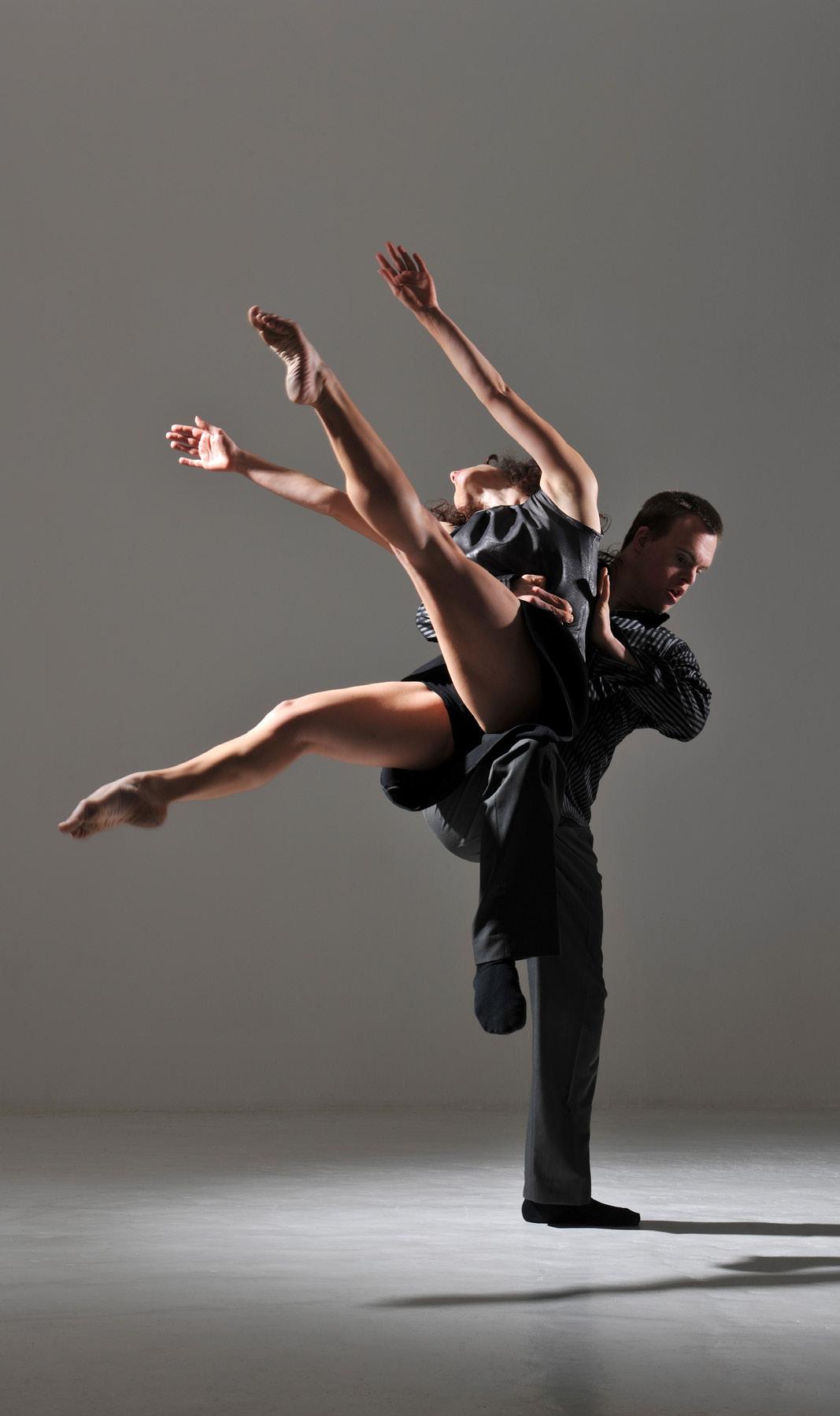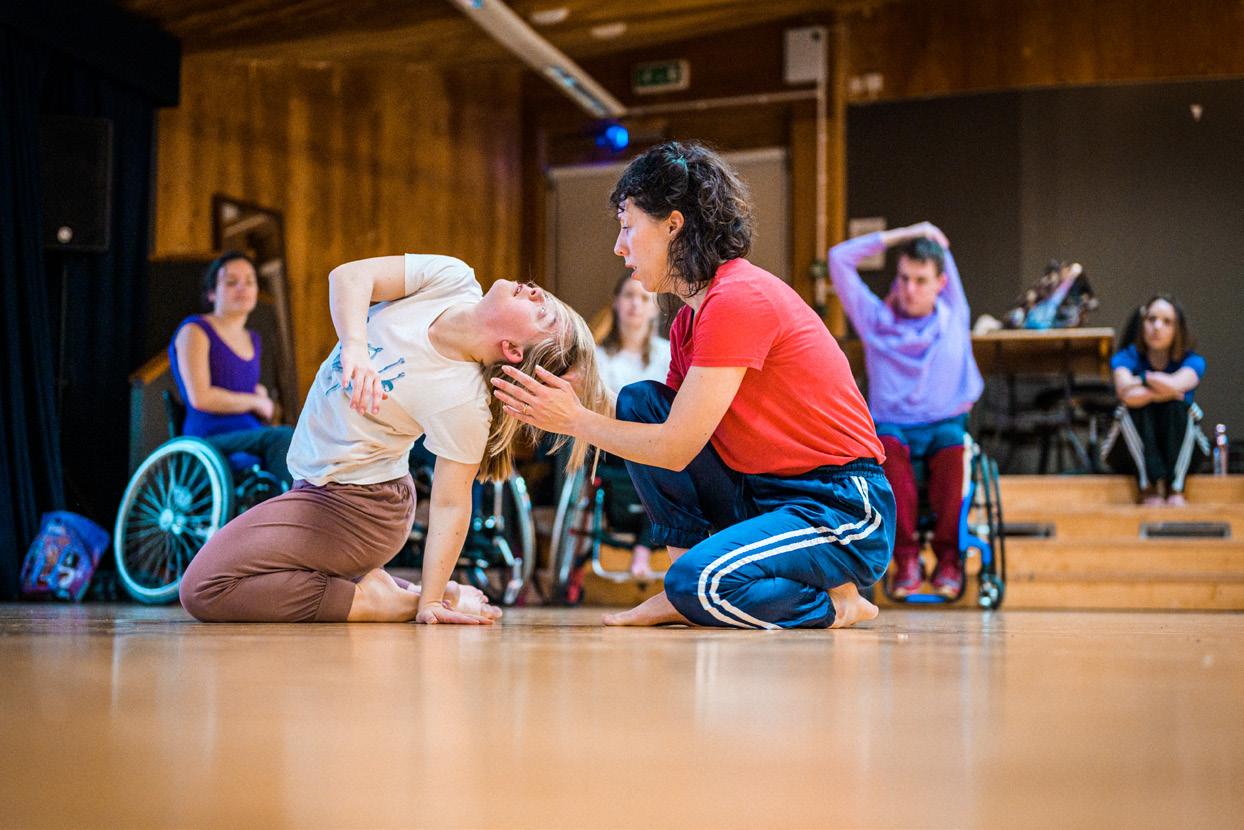
6 minute read
Inclusion and Rigour Are Not Binary
20 years of innovation in inclusive practice at Stopgap Dance Company
January 2023 marks 20 years since Lucy Bennett, Laura Jones and Chris Pavia began their careers with Stopgap Dance Company. Lucy and Laura are now Co-Artistic Directors, and Chris is a resident choreographer.
In this article, Lucy, Laura and Chris reflect on their journey of innovating inclusive dance, and what next for Stopgap.

Stopgap Dance Company in rehearsal
Photo: Chris Parkes
How did you develop inclusive choreography and why is it important to have inclusivity at the core of what you do?
Lucy: Stopgap was a repertoire company when we first joined as dancers. Back then, choreographers would come in to make work and sometimes set tasks coming from non-disabled perspectives. We would collectively figure out things like, how can we achieve unison amongst the different rhythms and physicality of our diverse bodies when the choreographer wanted us to move like them to specific counts? We would spend many hours observing each other’s dance habits or functional movements and find hooks that helped us stay connected as a group.
We immediately felt that the outcome was richer with the diverse dancers engaging in a dialogue, and this is how our inclusive creative process developed. We’re now a devising company, and our creativity is led by this inclusive mindset instead of tagging it on at the end once the choreographer has made up the material.
Laura: Our creative process goes through the cycle of ‘reinvent, reflect and refine’, and it gradually led us away from ‘adaptation’ to ‘translation’’. Inclusive choreography is a two way conversation. It doesn’t have to be disabled people adapting non-disabled people’s material. Material making can be initiated by disabled dancers, and different people engaging in a creative dialogue gives richness to our work.
Chris: Stopgap gave me opportunities to practice choreography from when I started with the company, and it was exciting to choreograph The Awakening for the national touring of outdoor festivals in 2014. That got me the chance to make the video installation piece at Watts Gallery last year.
Lucy Bennett
How did you develop your inclusive training?
Laura: Back when we started, dance classes for disabled people were largely based on improvisation. Technique class was seen to be exclusionary, but Stopgap explored how it could be taught inclusively because improvisation, as valuable as it is, was only giving disabled dancers exposure to one aspect of dance.
Lucy: We broke down the essence of what a technique was trying to achieve and found a way to translate this onto different bodies and learning styles. This process of investigation has now become a collective responsibility and actually takes a leaf out of improvisation. We all have to focus on the intention of an exercise and open a conversation about it.
Our inclusive practice is also based on translation and not adaptation, so our dance classes are never hierarchical. It can be a physically disabled person teaching and opening a dialogue with the standing dancers about a movement they made on their body, or it can go the other way.
Laura: We were innovating conventional technique classes through the cycle of ‘reinvent, reflect, refine’. It underpins our practice in training and creativity and once we started saying that “our dance practice enables diverse dancers to get to know their own bodies”, the penny dropped. Classes need to be designed so that disabled and non-disabled dancers can continue to sharpen their bodies as tools for expression. This is important if you want to be a consistent and professional performer.
Chris: I like improvisation, but I also like it when people like Laura take the time to show me different ways of doing an exercise. Lucy: Even now, we hear about disabled dancers in training not being given access to the same technique classes that their non-disabled peers get. People still assume that disabled dancers can only do improvisation, but we want institutions, companies and teachers to change their attitude and co-design provision through an ongoing conversation with disabled dancers.
Laura Jones

'Within' by Thomas Noone
Photo: Hugo Glendinning
What’s next for your work with Stopgap Dance Company?
Laura: 2023 will start with the continuation of a partnership project with 'Oriente Occidente', which is supported by the British Council’s International Collaboration Grant. We’re aiming to embed inclusive dance in Italy in collaboration with two disabled Italian dance leaders Aristide Rontini and Giuseppe Comunielo. We then run the fourth edition of our online teacher training course Seedbed, so 2023 will be a busy start for me.
Chris: I premiered a new outdoor duet called 'Echoes From The Earth' for the National Trust this summer. It’s made for the woodlands and forests, and I hope it will tour around the countryside next year.
Lucy: Stopgap will be making a new indoor show called 'Lived Fiction', and I feel this is the production that 20 years of our experience is leading us to. 'Lived Fiction' will be an exciting piece of dance work that has creative access firmly integrated.
During lockdown, we made 'Dance Tapes', which were a series of digital solo dance works that are sound and spoken-word only. It combines audio description and self-felt experience of disabled dancers with supportive sound composition by Moulettes. It was made with visually impaired audiences in mind, and we developed creative transcripts for D/deaf audiences. We’re putting what we learned in 'Dance Tapes' into ''Lived Fiction', a live work. It will celebrate everything that inclusive choreography has to offer. We’re petrified by our own ambition, but 'Lived Fiction' will hopefully entice the sector to go further with inclusion and integrated access.
Further information
www.stopgapdance.com






